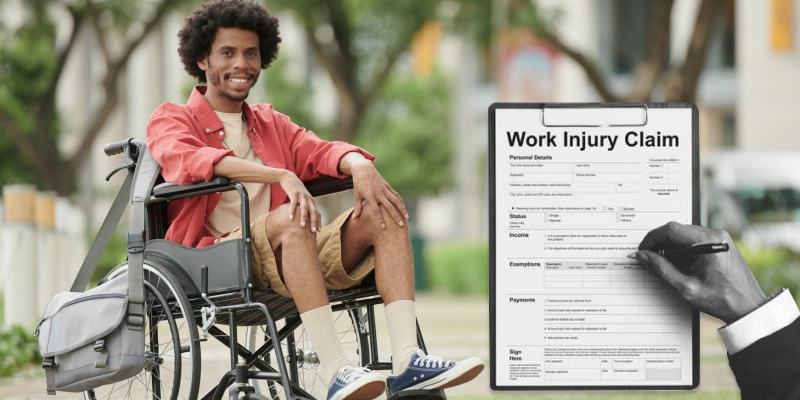Workers’ compensation is a vital support system for workers who don’t fully recover from an illness or injury sustained from their workplace. California’s workers’ compensation insurance provides various benefits, including disability benefits, to help employees recover and recover and rehabilitate to their previous or new employment, should they so choose.
Companies and their workers should have a perfect understanding of disability benefits to navigate the system’s complexities and ensure just payment for injured employees. Certain permanent employee benefits are available to California employees if they have suffered a lasting partial disability from their work illness or injury. This blog post will discuss the primary aspects of disability payments under California workers’ compensation, including details regarding the types of disabilities and requirements for each.
What You Should Know About Permanent Partial Disability And Workers’ Comp!
Depending on your severity of your occupational illness, you may be eligible for “permanent partial disability” or “permanent total disability” compensation.
The Difference Between Permanent Partial Disability and Permanent Total Disability
According to California’s PD Rating system for injured workers, permanent total disability refers to complete permanent disability, whereas permanent partial disability is a permanent disability that is less than 100%. The majority of injured workers who suffer from permanent disability are unable to return to their jobs.
In most cases, if an injured worker is declared permanently disabled (aka qualifying for permanent total disability benefits), they will continue receiving workers’ compensation benefits for the rest of their lives. Usually, these benefits will be equal to the amount they received in temporary disability benefits, which is two-thirds of their pre-injury average weekly salary. The amount may fluctuate since the maximum and minimum benefit rates are modified yearly. This is because it is subjected to California’s maximum and minimum benefit rates.
What Is Permanent Partial Disability?
Permanent partial disabilities are defined as any disability less than 100%. Your P.D. rating, or the percentage of your disability (up to 99.75%), determines how many bills you receive and how long these payments will last.
The first step of your PD ratings starts with one or more medical reports. Initially, your treating doctor writes a report evaluating any long-term disabilities you may have due to your injuries (usually around the same time as the P&S report). This is the precise amount you can no longer use the injured part of your body, physically usually (or psychologically). For instance, you might have reduced hand-grip strength, severely restricted knee motion, or an amputated finger.
When reporting your impairments, there are specific guidelines that physicians must adhere to. A qualified medical evaluator (QME) might be chosen to provide an additional expert opinion on the contested topics if the insurance company (or you) disputes the report’s conclusions.
How Permanent Partial Disability Benefits Are Calculated!
You might be wondering what benefits you are eligible for and how they are determined if you have experienced a permanent partial disability. The amount you receive depends on your average weekly income (before the injury) and your percentage of permanent disability. You might get the money all at once as a lump sum settlement or get a series of checks for this amount over a predetermined time.
Factors That Influence Your Disability Percentage
Different factors determine the disability percentage of an injured worker. The first factor includes medical reports of the injury. In most cases, the injured worker’s treating doctor writes the medical report illustrating any permanent disabilities resulting from the work injury, meaning the extent to which the injury has caused physical damage to the worker. Most of the time, another physician, a Qualified Medical Evaluator (QME), prepares a report outlining their conclusions about the nature of the worker’s injury. When there are disagreements in a case, a QME is asked to create a report.
Your doctor’s report is used to establish the permanent disability ratings. The doctor’s report is used to create a rating report, often using a complex formula established by the state that considers your age, occupation, and physical or mental functional limits.
Furthermore, California mandates that doctors apportion any permanent injury they discover between your work injuries and any factors they believe are causing your permanent disability. When appropriate, the doctor’s report determines what percentage of your permanent disability is directly related to your work injury and what percentage is caused by other factors (including prior injuries). A prior injury doesn’t qualify you for benefits from the worker’s illness or injury, but it is an essential factor.
Permanent Total Permanent Disability (P.D.)
You must note that a permanent total disability award is quite rare. The law presumes that the injured employee is permanently disabled only in extreme circumstances (e.g., losing both legs, eyesight, or quadriplegia).
Eligibility For Permanent Disability Award (It All Depends On Your Disability Ratings)
You’re eligible for total P.D. benefits only if you cannot work in any capacity as long as you live.
California’s workers’ compensation law requires a doctor’s report stating that your recovery has plateaued to become eligible for permanent disability compensation. Your physical condition will not likely improve beyond this point despite your medical healing despite ongoing medical treatment. This specific recovery plateau is defined as the “maximal medical improvement” (MMI) and “permanent and stationary” (P&S). Thus, you will no longer get temporary disability benefits after you reach MMI. However, you won’t receive permanent disability benefits if you’ve recovered fully and can return either if you’ve recovered fully and can get back to your job without further restrictions.
Let’s Discuss Physical Disability Ratings In Detail
A Permanent Disability rating, or how much your disability impacts the kind of employment you can do, is translated from the doctor’s information report. The state-mandated rating method for P.D. includes a complex calculation (sometimes called a “schedule”) that considers your age, occupation, and physical or mental impairments. When determining the final rating, the Disability Evaluation Unit in California’s Division of Workers’ Compensation (DWC) may be questioned by your lawyer or insurance company. This happens automatically if you are pursuing a QME and are not represented. However, we suggest you contact one of our qualified and experienced permanent partial disability workers compensation lawyers to avoid the headache of tackling insurance companies and their misleading tactics.
Apportionment of permanent disability between old and new injuries
A pre-existing medical condition may not stop your workers’ compensation if your recent illness or accident at work worsened or “greenlit” it. California requires physicians to “apportion” your permanent impairment between your previous and current injuries to determine P.D. payments. Whenever applicable, the doctor’s report must establish the proportion of your permanent disability that resulted directly from the illness or work-related injury you are claiming and what percentage was caused by other factors, such as previous injuries.
Your Path to Recovery with PPD Benefits

Conclusion
Generally, when it is determined that an injury sustained at work has resulted in permanent disability, the injured worker typically gets permanent partial disability compensation. These payments don’t go indefinitely. Instead, they are issued for a predetermined number of weeks. Your disability rating and the date of your injury determine how long you will be eligible for permanent partial disability compensation. Since each workers’ compensation case is unique, your lawyer can provide further information about the benefit payments you can anticipate.
We understand the complexities of navigating the legal process. We are here to offer you the help and direction you require to negotiate successfully for your permanent partial disability. Reach out to us today to help yourself reach the path of recovery. Schedule a Call with one of our workers’ compensation lawyers for guidance and support and to ensure you get the benefits you deserve.
Frequently Asked Questions (FAQs)
1. How is Permanent Partial Disability determined?
After reaching Maximum Medical Improvement (MMI), the condition becomes stable and cannot be expected to improve. In this case, a doctor evaluates the disability and assigns it a percentage rating. The rating represents how severe the disability is and its effect on the person’s work capacity.
2. How are PPD benefits calculated?
PPD benefits are normally computed on a basis of two-thirds of the employee’s pre-injury average weekly wages within minimum and maximum amounts provided in California law. The disability rating determines the time duration of the benefits; higher ratings often equate to longer benefit duration.
3. Can I work while receiving PPD benefits?
Yes, many people are able to continue working while on PPD benefits, particularly if they can do modified jobs or reduced shifts that meet their needs. The details may differ depending on the person’s situation and the requirements of an employee.
4. How long do PPD benefits last?
The duration of PPD benefits is based on the disability rating and associated benefit schedule in California’s workers’ compensation laws. For example, a greater disability rating could provide a worker with benefits for a longer period of time.









